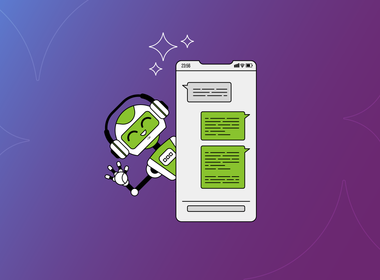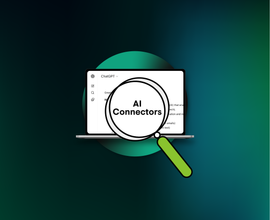The 10 Best AEO / GEO Tools in 2025: Ranked and Reviewed
AI-powered search engines like ChatGPT, Perplexity, and Google AI Overviews are changing how people find information—a change that requires specialized tools built specifically for AI search. We tested the top AEO tools to see which ones actually help you earn citations in AI-generated responses, not just monitor where you appear.
This guide breaks down what each AEO tool does well, where it falls short, and which teams it's built for, so you can choose the one that fits your workflow and start building visibility that actually drives results.
Your content could be ranking #1 in traditional Google search—and users still won't click it.
That's the new reality of search. Google's AI Overviews answer questions directly at the top of results. ChatGPT Search pulls from the web to deliver complete responses. Perplexity synthesizes multiple sources without sending anyone to your site. Users get what they need without ever leaving the search platform.
If your brand isn't being cited in these AI-generated responses, you're invisible. Competitors who are getting mentioned are capturing the traffic, trust, and market share that should be yours.
That's where Answer Engine Optimization (AEO) tools come in. You need specialized AEO tools that track your presence across AI search engines, analyze citation patterns, and guide optimization for how LLMs actually use content.
We've tried and tested the best AEO tools available in 2025, ranking each on AI visibility tracking, content optimization features, data accuracy, usability, enterprise capabilities, and integrations. Whether you're managing enterprise operations or building your first AI visibility strategy, this guide will help you find the right solution.
What are AEO tools?
Let's say your blog post ranks #1 for "enterprise project management best practices." Great, right? Except now, when someone searches that term, Google's AI Overview synthesizes an answer from five different sources—and yours isn't one of them. You have the best content, the highest ranking, and zero visibility where it actually matters.
That's the problem AEO tools solve. Answer Engine Optimization (AEO)—sometimes called Generative Engine Optimization (GEO)—is the practice of optimizing your content so AI-powered search engines cite your brand when answering user questions.
AEO tools are the platforms that make this possible by tracking where your brand appears (or doesn't appear) in AI-generated responses across Google AI Overviews, ChatGPT Search, Perplexity, Claude, and other answer engines that are reshaping how people find information.
These platforms work fundamentally differently than traditional SEO tools because they solve different problems. Your existing SEO platform tracks keywordKeyword
A keyword is what users write into a search engine when they want to find something specific.
Learn more rankingsRankings
Rankings in SEO refers to a website’s position in the search engine results page.
Learn more, backlink profiles, and organic traffic—all metrics designed for a world where success meant getting users to click through to your site.
In contrast, AEO / GEO tools:
- Track whether AI engines mention your content when they answer questions
- Analyze why certain sources get cited over others
- Benchmark your visibility against competitors across AI platforms
- Provide optimization guidance tailored to how LLMs actually evaluate and synthesize information.
The best ones also integrate with your content creation process, helping you build answer-ready content that's structured and formatted to maximize your chances of being cited from the moment you publish.
The 10 best AEO / GEO tools for 2025
1. Conductor
Conductor is the only end-to-end, enterprise AEO platform built on the industry's most complete data engine. Combining AEO / GEO and traditional SEO in one solution, the platform connects AI visibility tracking with content creation and real-time site monitoring—all powered by 10+ years of unified website data.
Why it ranked #1: Conductor is the only end-to-end platform on this list. While other tools are point solutions focused solely on tracking AI citations, Conductor connects AI visibility insights to content creation workflows and SEO operations. Instead of reports that force you to switch tools to take action, you get insights you can act on immediately and measure impact in the same platform.
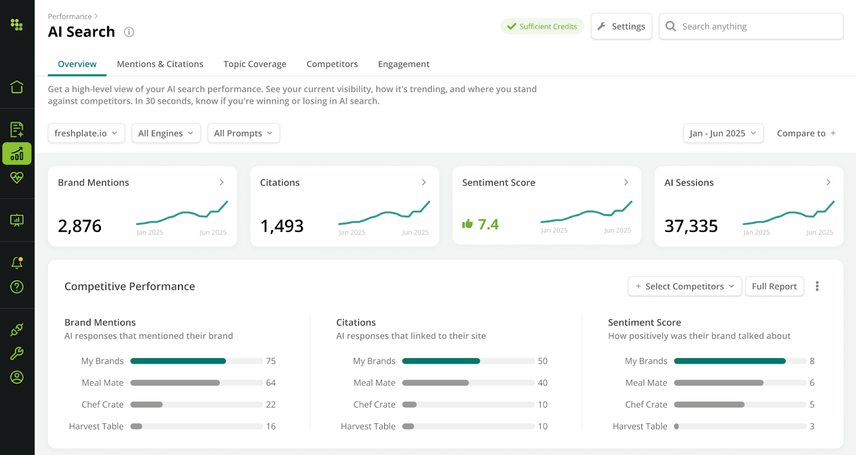
Differentiators:
- Direct OpenAI partnership enabling API-based data collection
- 10+ years of unified website data powering insights
- Writing Assistant that generates on-brand content optimized for search and AI citations
- Real-time website monitoring with integrated technical health alerts
- SOC 2 Type II certification with unlimited users included
Drawbacks:
- Custom pricing structure without public transparency
- Potential learning curve for full platform adoption
Best for: Enterprise teams that want to eliminate tool sprawl and connect AI visibility to content execution.
Pricing: Custom pricing. Free trial available.
2. Semrush
Semrush is a comprehensive SEO tool that has added AI visibility features to its existing suite of tools. Originally built for keyword research, competitive analysis, and traditional SEO, the platform now includes capabilities for tracking and optimizing content for AI-powered search results.
Why it ranked #2: For teams already invested in Semrush's enterprise platform, the AI visibility features offer a convenient expansion without tool sprawl. You get AI Overviews tracking alongside established SEO capabilities in one ecosystem. However, the AI search functionality sits within Semrush's broader 45+ report structure, meaning AI data doesn't flow seamlessly with traditional metrics—creating some navigation challenges for teams trying to connect insights across channels.
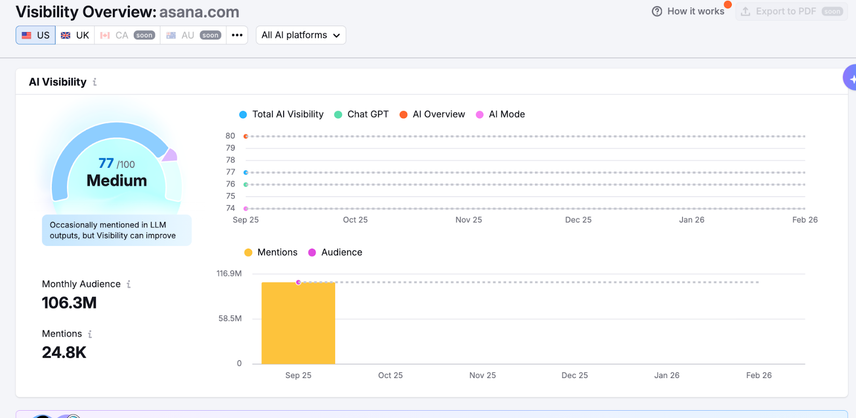
Differentiators:
- Established SEO platform with broad feature set covering technical, content, and competitive analysis
- Large user base with extensive educational resources and community support
- Keyword tracking that spans both traditional search rankings and AI visibility
- Competitive research tools for analyzing competitor strategies
Drawbacks:
- Fragmented experience with disconnected reports separating AI visibility from traditional SEO data
- Per-user licensing model increases costs significantly for larger teams
- Generic AI content recommendations that lack personalization to your brand or competitive set
- Lower global search engine coverage compared to enterprise platforms
Best for: Mid-market teams already using Semrush who want to add basic AI visibility tracking without switching platforms.
Pricing: Plans start at $139.95/month. Custom enterprise pricing available.
3. Profound
Profound is an AI visibility tracking platform that monitors brand citations across answer engines. The platform specializes in showing you when and how AI-powered search engines like ChatGPT, Perplexity, Google AI Overviews, and Claude mention your brand, with competitor benchmarking and citation analysis to help you understand your AI search performance.
Why it ranked #3: Profound delivers comprehensive tracking across major AI platforms with detailed competitor benchmarking that shows exactly where you're winning and losing visibility. The interface makes complex citation data accessible, helping teams quickly spot trends and opportunities. Where it falls short is execution—you can see what's working and what's not, but you'll need separate tools to create optimized content and measure the full impact of your changes.
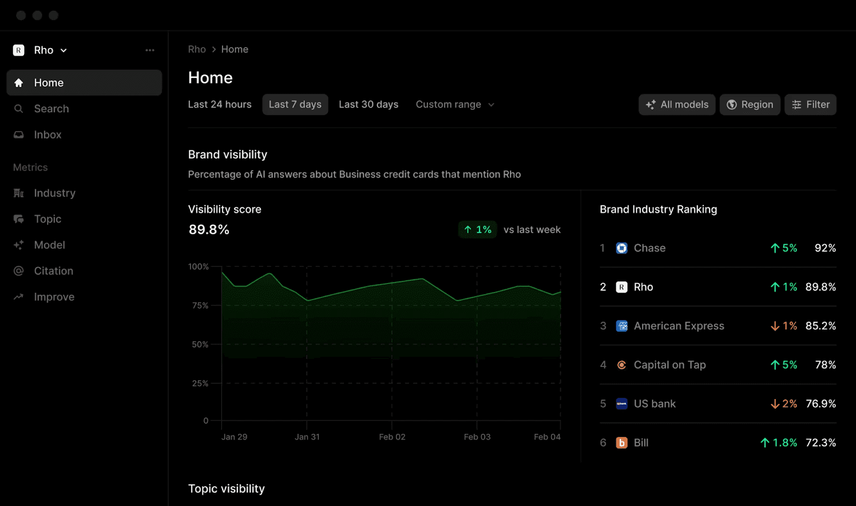
Differentiators:
- Multi-platform tracking across ChatGPT, Perplexity, Google AI Overviews, and Claude in a unified dashboard
- Citation pattern analysis that reveals why specific content gets referenced over competitors
- Query-level insights showing which user questions drive brand mentions
- Competitor visibility benchmarking with historical trend data
Drawbacks:
- Point solution focused solely on tracking—no integrated content creation or website monitoring to act on insights, optimizations, or measurements
- Relies on data scraping rather than direct API partnerships, which can affect data accuracy and consistency
- Limited technical SEO features beyond AI visibility
Best for: Teams seeking in-depth AI citation tracking and reporting, but have less established workflows for content optimization.
Pricing: Custom enterprise pricing only.
4. Writesonic
Writesonic is an AI content generation platform that has expanded into AEO with features designed to help content rank in AI-powered search results. The platform combines AI writing capabilities with optimization recommendations, helping teams create content that's structured for visibility in answer engines.
Why it ranked #4: Writesonic brings content creation directly into the AEO conversation, making it easy to generate content with AI visibility in mind from the start. The platform is strong for teams that need to produce content at scale, with bulk generation features and integrations that streamline publishing workflows. The tradeoff is that AI visibility tracking is basic compared to specialized platforms, and content quality requires human editing to avoid generic outputs.
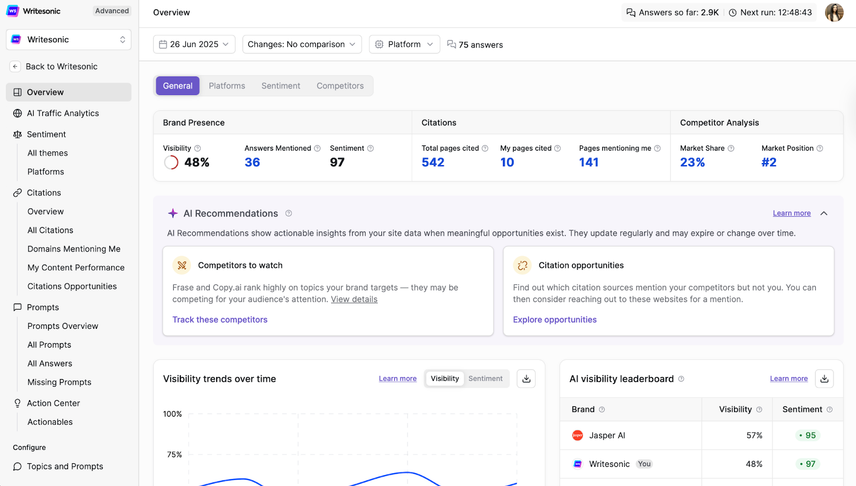
Differentiators:
- AI-powered content generation with built-in AEO optimization prompts
- Chrome extension for on-the-fly content creation and optimization
- Bulk content generation features for scaling production across multiple topics
- Native integrations with WordPress, Shopify, and other content management systems
Drawbacks:
- Limited AI visibility tracking compared to dedicated AEO platforms like Conductor or Profound
- Content can read as generic without significant human review and editing
- No comprehensive website monitoring or technical SEO capabilities
Best for: Content teams that prioritize production speed and volume with basic AEO optimization needs.
Pricing: Plans start at $12/month. Enterprise pricing available.
5. Athena
Athena is an AI search intelligence platform that focuses on understanding how AI engines use and cite content. The platform provides detailed analysis of citation patterns and content structure, helping teams understand the mechanics behind why certain content gets referenced in AI-generated responses.
Why it ranked #5: Athena differentiates itself through analytical depth, digging into why content gets cited rather than just tracking whether it does. The platform excels at revealing content patterns and structural elements that drive visibility, but that depth comes with complexity. The learning curve is steeper, and the insights may overwhelm teams looking for straightforward guidance rather than granular analysis.
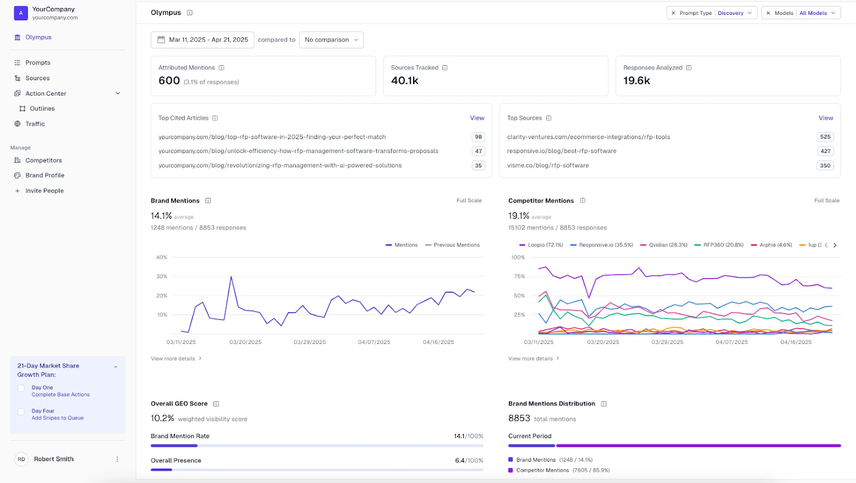
Differentiators:
- In-depth citation analysis revealing specific content patterns and structural elements that drive visibility
- Content structure recommendations based on successful citations across your industry
- Cross-platform tracking with detailed attribution data showing citation sources
- Focus on the "why" behind AI visibility metrics, not just performance tracking
Drawbacks:
- Steeper learning curve due to the analytical depth and complexity of data
- Higher price point reflecting specialized enterprise capabilities
- May provide more data than smaller teams can realistically act on
Best for: Data-driven enterprise teams that want deep insights into AI citation mechanics and have the resources to implement findings.
Pricing: Contact for pricing. Enterprise-focused.
6. Surfer SEO
Surfer is a content optimization platform that has expanded from traditional SEO into AI search optimization. Recently acquired by Semrush, Surfer was originally built for analyzing what makes content rank in Google. The platform now includes features designed to help content perform in AI-generated search results.
Why it ranked #6: Surfer brings established content optimization expertise to AEO, with a strong foundation in analyzing successful content patterns. The platform works well for teams already using Surfer who want to extend their optimization efforts into AI search. The limitation is that AI visibility features feel secondary to the core SEO product—tracking is less developed than content optimization, and the per-article pricing model gets expensive when scaling AEO efforts across large content libraries.
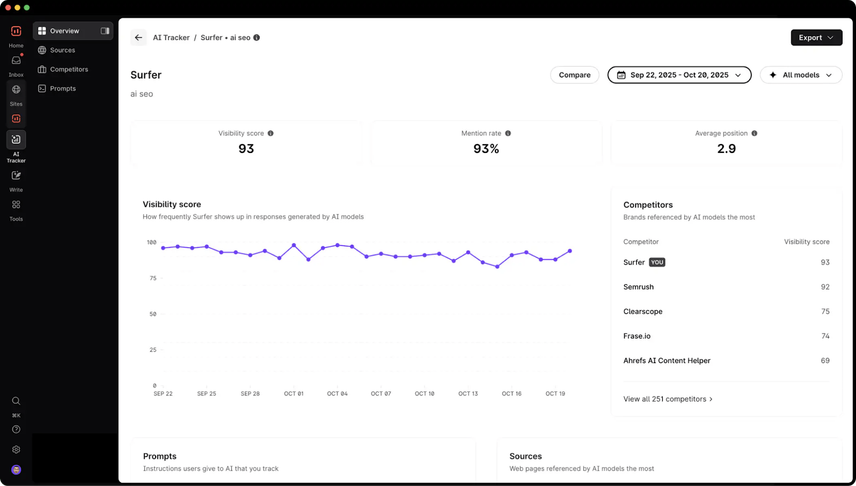
Differentiators:
- Content editor with real-time optimization suggestions for both traditional and AI search
- NLP that analyzes semantic relevance and content quality
- Native integrations with Google Docs and WordPress for streamlined workflows
- Established platform with proven content optimization methodology
Drawbacks:
- AI visibility tracking capabilities lag behind dedicated AEO platforms—no comprehensive cross-platform monitoring
- Per-article pricing model becomes expensive at scale for enterprise content operations
- No real-time website monitoring or technical health alerts
Best for: Content creators and SEO teams already using Surfer who want to extend optimization efforts to include AI search.
Pricing: Plans start at $99/month. Custom enterprise pricing available.
7. Scrunch
Scrunch is an AI visibility platform that focuses on tracking brand mentions across AI-powered search engines. The platform monitors when your brand appears in AI-generated responses, which queries trigger those mentions, and how your visibility compares to competitors.
Why it ranked #7: Scrunch delivers a focused solution for teams that want straightforward AI visibility tracking without the complexity of larger platforms. The interface is clean and the reporting is easy to understand, making it accessible for teams new to AEO. The tradeoff is limited scope—you get visibility tracking and that's it. Content optimization, technical SEO, and workflow integrations all require separate tools, and the smaller platform means less established support infrastructure.
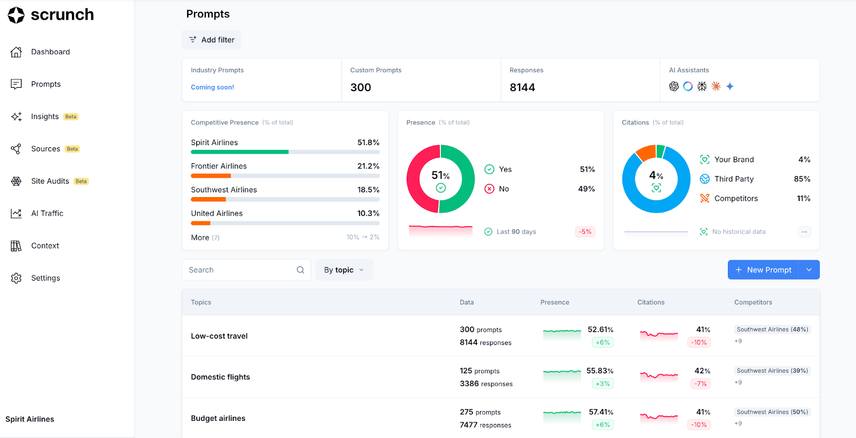
Differentiators:
- Clean, focused interface designed specifically for AI visibility tracking
- Brand mention monitoring across multiple AI platforms with clear reporting
- Query analysis showing which user searches trigger brand citations
- Competitive tracking for benchmarking your visibility against key competitors
Drawbacks:
- No content creation or optimization features to act on visibility insights
- Limited integration capabilities with other marketing and content tools
- Smaller platform with less established customer support infrastructure
Best for: Brands that need basic AI visibility tracking and prefer a simple, dedicated solution over complex enterprise platforms.
Pricing: Contact for pricing.
8. Peec AI
Peec.ai is an AEO platform that helps brands understand and improve their visibility in AI-generated search results. The platform combines visibility tracking with actionable recommendations, focusing on translating data into specific optimization guidance.
Why it ranked #8: Peec.ai attempts to bridge the gap between tracking and action by providing specific recommendations for improving AI visibility. While most platforms stop at showing you where you appear, Peec.ai guides you on what to do about it. The challenge is execution—recommendations still require manual implementation in separate tools, the platform has limited historical data compared to established competitors, and coverage across AI platforms is narrower than enterprise solutions.

Differentiators:
- Actionable optimization recommendations based on AI citation patterns and successful content analysis
- Focus on explaining the "why" behind citations, not just tracking the "what"
- User-friendly dashboard designed for accessibility across technical and non-technical team members
- Regular platform updates that respond to changes in how AI search engines operate
Drawbacks:
- Recommendations require manual implementation in separate content and publishing tools
- Limited historical data compared to more established platforms
- Smaller coverage of AI platforms compared to enterprise solutions
Best for: Marketing teams that want guidance on improving AI visibility alongside tracking capabilities.
Pricing: Contact for pricing.
9. Goodie
Goodie is an AEO platform designed to help brands monitor and optimize their presence in AI-generated search results. The platform emphasizes simplicity and quick implementation for teams new to AI search optimization.
Why it ranked #9: Goodie makes AEO accessible for teams that find other platforms overwhelming. The straightforward approach and shorter onboarding process appeal to organizations taking their first steps into AI visibility. That simplicity comes with limitations—advanced features for sophisticated analysis are missing, platform coverage is narrower than enterprise solutions, and optimization recommendations are basic compared to higher-ranked tools.
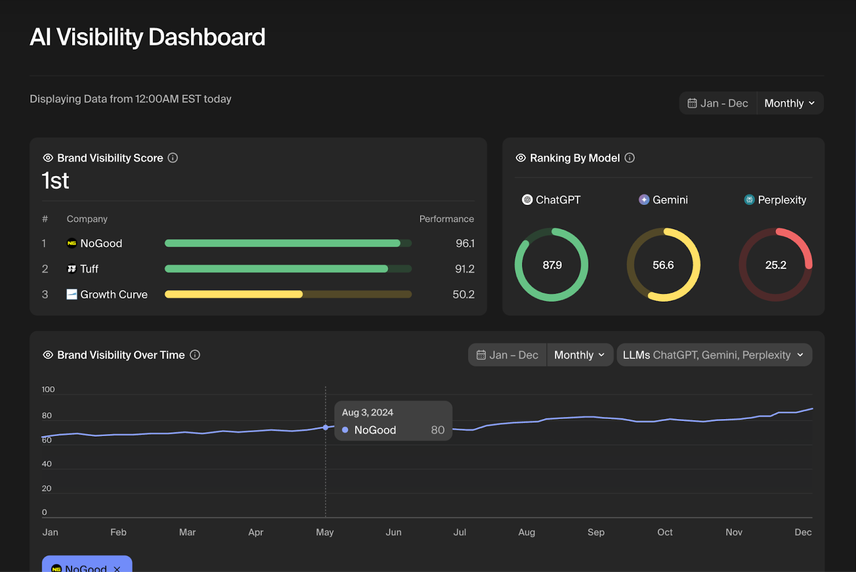
Differentiators:
- Simplified onboarding process designed for AEO beginners
- Streamlined reporting focused on essential metrics without overwhelming data
- Quick setup with minimal technical requirements
- Lower price point than enterprise-focused competitors
Drawbacks:
- Limited advanced features for sophisticated analysis and optimization
- Smaller platform coverage compared to enterprise solutions
- Basic optimization recommendations that lack depth
Best for: Small to mid-market teams new to AEO that prioritize ease of use and quick implementation over advanced capabilities.
Pricing: Plans start at $99/month.
10. Ahrefs
Ahrefs is a comprehensive SEO platform known for backlink analysis, keyword research, and site auditing. While not originally built for AI search optimization, recent updates have added entityEntity
An entity is a thing/concept that search engines and AI models can identify and relate to other entities, forming the foundation of semantic search.
Learn more tracking, snippet monitoring, and AI visibility features that give teams some foundation for AEO work alongside traditional SEO capabilities.
Why it ranked #10: Ahrefs delivers strong data accuracy for backlinksBacklinks
Backlinks are links from outside domains that point to pages on your domain; essentially linking back from their domain to yours.
Learn more and keyword visibility, with recent additions like featured snippet prediction and entity mapping adding relevance for AI search. However, it prioritizes traditional SEO over purpose-built AEO capabilities—making it better suited for teams focused on conventional search who want basic AI visibility awareness.
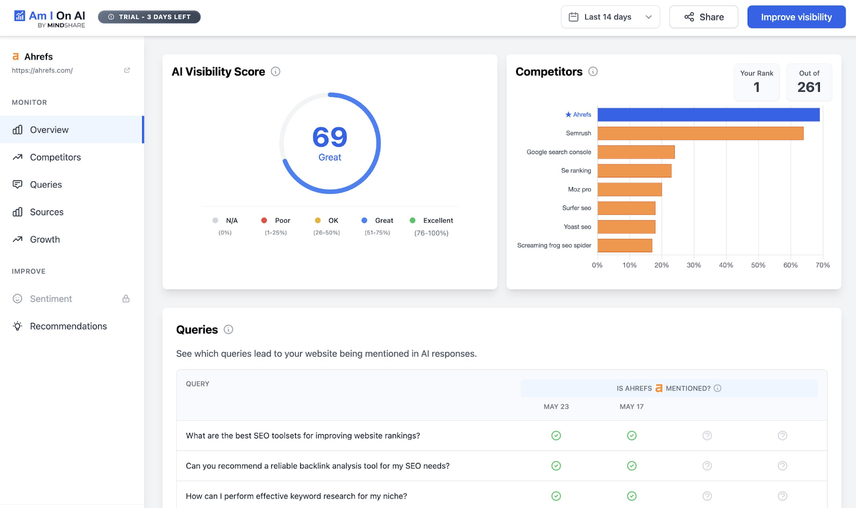
Differentiators:
- Industry-leading backlink database and link intelligence
- Advanced keyword research with SERP feature tracking
- Emerging entity and snippet visibility reports
- Comprehensive site audit functionality
Drawbacks:
- Limited AEO tracking compared to specialized tools
- No integrated content optimization workflows
- Higher pricing with user and data restrictions
- Less flexible reporting than enterprise platforms
Best for: SEO teams prioritizing technical SEO who want foundational AI visibility tracking without deep AEO integration.
Pricing: Plans start at $99/month (Lite) and scale to $999/month (Enterprise), with custom enterprise pricing available.
In summary
The right AEO / GEO tool depends on where you are in your AI search journey and what you're trying to accomplish. Start by asking what problem you're actually solving. If you just need to know whether your brand shows up in AI responses, a basic tracking tool might work.
But if you're building a sustainable AI visibility strategy—one where you can create optimized content, track performance, and prove ROI—you need a platform that connects insights to execution. That's why Conductor tops this list.
Three factors separate the platforms that deliver from those that create more work:
- End-to-end workflow optimization. All-in-one platforms unify AI visibility, content performance, and technical health so insights inform each other automatically. Point solutions create data silos where patterns emerge too late and opportunities require manual detective work to connect.
- Purpose-built AI. Years of performance data reveal which tactics actually move the needle versus which don’t. AI built on proven performance history delivers insights grounded in reality, not assumptions.
- Insights that drive action. Finding problems doesn't improve visibility. Fixing them does. By connecting discovery to optimization, you eliminate the steps where most teams lose momentum.
When your visibility strategy lives in one platform, every action compounds. Conductor brings your data, insights, and content together so you can see what’s working, fix what’s not, and scale what drives results. It’s not just about tracking AI answers—it’s about shaping them.
